Race cars make terrible street cars – but every now and then, one will be offered for sale to the general public.
Usually, briefly.
L-88 Corvettes with lumpy solid lifter cams and three Holley two barrel carbs. SD-421 Catalinas with acid-dipped frames.
Cobra R Mustangs with Tremec five-speeds, no insulation or AC and radio delete.
They come . . . and they go.
One of the few to last ten years in production was Honda’s S2000 roadster – from its introduction in late 1998 as a new 1999 model all the way to ’09, when the last one left the Takanezawa factory in Japan.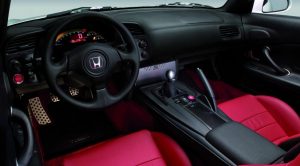
That’s a record no other truly hard-core production car has come close to matching.
The S2000 came to Honda stores on the same trucks that carried Civics and Accord – and was fully factory warranted, just like them.
It looked docile enough – a kind of more angular Miata. The cars were about the same size and similarly laid out: Front engine, rear-wheel-drive. Both had fairly small four cylinder engines, too.
But the 16 valve, variable cam timing (VTEC) 2.0 liter four under the hood of the S2000 was more like something you’d find under the tank of a high-performance motorcycle.
It had a 9,250 RPM redline and it didn’t make much power until it was spinning around 6,000 RPM – at or very near redline for most street car engines.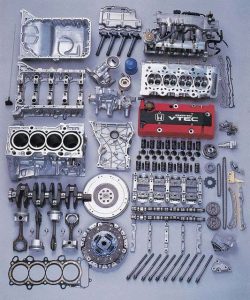
And it made almost no torque until it was spinning 7,500 RPM (well past the Miata’s 6,500 RPM redline).
This made driving it at anything less than 7,500 RPM kind of like trying to run fast in foot-deep mud.
Though capable of getting to 60 in just over 5 seconds, if you didn’t bring the revs up and feather the clutch at launch, the car would either stall or fall flat on its face like an old two-stroke Kawasaki. There were basically two speeds: light – and dead slow.
It was not stop-and-go, commute-friendy car.
But once you got into the powerband and the VTEC four woke up, look out. It was like that moment in the original Star Wars when Han and Chewie finally get the Falcon’s faster-than-light drive working and the view outside blurs as the light bends and they leave Darth Vader far, far behind them. At anything less than light speed, though, the S2000 was unhappy.
And so, probably, were you.
The sweet spot was around 90 MPH with the tach hovering at around at 6,000 in fourth gear – the cams ramped up and ready for business.
Now, it pulled.
Total output was 247 hp – a big number for a non-turbo four back in ’99 and even today.
Honda engineers squeezed more power-per-liter out of the S2000’s engine than Dodge managed to coax out of the same-year Viper’s monstrous 8 liter V10 – which only made 450 hp. Put another way, the combined output of just two S2000 engines ( 4 liters’ worth) equaled 480 hp.
Imagine four.
What made the S2000’s float-like-a-butterfly, sting-like-a-bee performance happen was very high compression (11.7:1) and the transit of great gulps of air through the four valve head – as well as the S2000’s other number: its 2,300 lb. curb weight.
The fatty Viper weighed 1,000 lbs. more – and was only just slightly quicker as a result.
The 2.0 liter engine’s cylinder block and head were cast of high-strength aluminum with fiber-reinforced steel liners and a ladder-type main bearing stiffener. An ultra-light (14 pound) balancer was used, to enhance the engine’s ability to rev freely – and fast.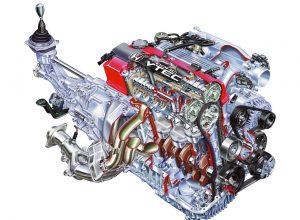
It wasn’t all engine, though.
Every S2000 came standard with a six speed manual transmission operated via a short-throw shifter, a Torsen limited slip differential (helpful when you got tail-out in a sweeper) and – later on – a variable gear ratio steering system (VGS) that reduced travel, lock-to-lock, from 2.4 turns at low speeds to 1.4 turns at high speed was available.
A near-perfect 50-50 weight split was achieved by mounting the engine aft of the front axle centerline. That plus ultra-performance Bridgestone Potenza S-02 tires gave the car the reflexes of a sport bike.
The only thing it didn’t do was lean.
And the sounds it made were like none other.
Well, maybe one other – the Acura NSX.
This was not coincidence. The same man – Shigeru Uehara – designed them both. Uehara was friends with Ayrton Senna and a big open wheel racing fan. That his cars reflected this passion was also not coincidental.
You felt like the pilot of an Indy car – or a liter class sport bike.
A Porsche 911 turbo may have been faster, but the S2000 felt fiercer.
But that kind of fun has its price – and the S2000’s was too high.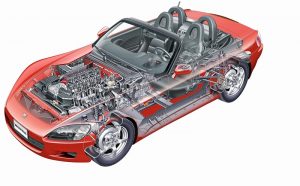
Unlike the Miata, which could be justified as fuel-efficient commuter car, the S2000 gulped gas at the Viper-esque rate of 18 city, 24 highway. That was if you kept it off the cams – and under 6,000 RPM.
Driven appropriately, the real-world average was high teens.
It was one of the hungriest four cylinder engines ever put into a street car.
For reference, a ’99 Viper – with an engine four times as large as the S2000’s – managed a not-bad-in-comparison 10 city and 19 on the highway. To reverse the horsepower-per-liter of displacement comparison made previously, the Viper’s appetite for fuel was actually less than the S2000’s, on a displacement-equivalent basis.
A same-year Miata delivered 25 city, 29 highway – and those were realistic numbers, because it wasn’t necessary to spin the engine to 6,000-plus and feather the clutch to get going without the car stumbling all over itself. And the Miata’s street-friendly four burned regular unleaded.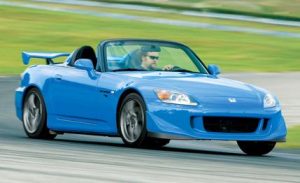
The S2000’s high-compression engine had to have premium unleaded.
You also had to have money for the car.
Though it didn’t cost Viper – or NSX – money, the S2000’s base price of about $30,000 in 1999 was the equivalent of about $44k in 2017 money.
It was one thing to spend that kind of dough on an Acura.
But a Honda?
Especially when a Miata was available for about $5,000 less (about $25k in ’99) and got 30-plus on the highway while burning regular instead of premium. Plus your wife could not drive it without stalling it – or burning up the clutch.
Beginning in 2004, Honda – recognizing the problem – made some changes intended to somewhat civilize the Wild Child. The 2.0 liter four was given a longer stroke and a bit more displacement (to 2.1 liters) which increased lower-end torque by about 6 percent – but at the price of revs and power. A revised ECU cut off the fuel at 8,200 RPM – a full 1,000 RPM lower than the original’s 9,200 RPM redline – and output was reduced to 237 hp at 7,800 RPM.
The six-speed manual’s gear ratios were also changed to give more mechanical leverage at lower RPM/road speeds (sixth/overdrive as made steeper to compensate for the higher fuel consumption that resulted from the revised first-through-fifth ratios).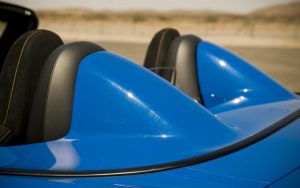
This made the car somewhat more stop-and-go tractable, but not enough to draw the volume buyers needed to sustain sales.
Miatas – which were available with an automatic transmission – had always been wife-drivable while the S2000 – even the detuned latter-day version – was anything but.
Sensing The End was near, Honda decided to go out with a bang. An ultra-light Club Racer variant painted Apex Blue – Shigeru Uehara’s favorite color – with a removable hardtop and no power actuation for the soft top, AC delete, staggered-size front/rear tires, additional frame bracing and no spare tire (every ounce counts) became available in 2008.
Honda had hoped to sell 2,000 of them but only about 700 buyers stepped up during the two years (’08 and ’09) the CR was available. By ’09, total sales were just barely over 700 – including the CR.
Part of this was due to the Wall Street Crash of 2008 – and the near crash of both the car industry and the general economy. It was not a good time for any car, much less a no-compromises car like the S2000.
Although Honda had reportedly been working on a second generation S2000 – possibly turbocharged, with more low-end torque and much more high-end horsepower – the Crash of ’08 put the kibosh on those plans.
It was a good run, while it lasted.
S2000 Trivia:
- The S2000’s name derives from the displacement of its 2.0 liter (122 cubic inch) engine, with the “S” referencing Honda’s classic S series roadsters (S500, S600, S800) of the 1960s.
- The S2000 was 162.8 inches long overall and rode on a 94.5 inch wheelbase. The same-era Mazda Miata was 156.5 inches long overall and rode on shorter (89.2 inch) wheelbase)
- The S2000 was one of the very first production cars to feature a race car-style push-button ignition. There was still, however, a physical key that had to be inserted before the push-button could be operated.
- In the Japanese home market, a Type S version similar to the U.S.-spec CR version was available during the final two years of the car’s production. It has the same body kit and short throw shifter, but retained the standard car’s power soft top and had different (more street-friendly) suspension tuning than the CR. All were painted fly yellow with black Alcantara suede interiors. About 1,755 Type models were made and all sold exclusively in Japan.
- In Europe, an Ultimate Edition and GT Edition were offered for the car’s final year in production (2009). The cars were mechanically the same as the standard S2000 but were painted Grand Prix White and had unique-to-this-trim red leather interiors. About 100 of these were built, making them the rarest of the breed.
Excerpted from the forthcoming (eventually) book, Doomed.





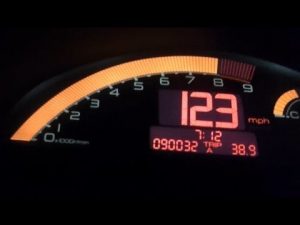
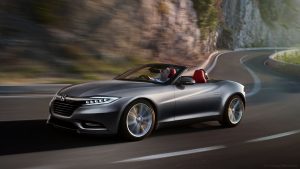






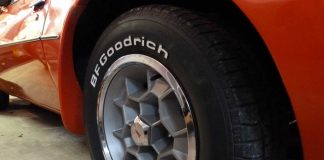
From Womb to Doom
We are the hollow men
We are the stuffed men
Every day simple things
Become more expensive
Leaning together
Headpiece filled with straw. Alas!
Our dried voices, when
We whisper together
Are quiet and meaningless
As wind in dry grass
Or rats’ feet over broken glass
In our dry cellar
Everyones homes and apartments become smaller
Everyday work hours grow longer but pay decreases
You see your family and friends less
But find in time that you care less about them
You find yourself lowering your standards
For work, food, relationships, job security
No longer exists as a concept
You start hanging on to cars and clothing longer and longer
There, is a tree swinging
And voices are
In the wind’s singing
More distant and more solemn
Than a fading star.
Let me also wear
Such deliberate disguises
Rat’s coat, crowskin, crossed staves
In a field
Behaving as the wind behaves
No nearer-
This is the dead land
This is cactus land
Here the stone images
Are raised, here they receive
The supplication of a dead man’s hand
Under the twinkle of a fading star.
The eyes are not here
There are no eyes here
In this valley of dying stars
In this hollow valley
This broken jaw of our lost kingdoms
Life is very long
Between the desire
And the spasm
Between the potency
And the existence
Between the essence
And the descent
Falls the Shadow
Jason Fenske (Engineering Explained youtube channel) documenting his trials and tribulations of owning an S2000.
https://www.youtube.com/watch?v=wf_ICA2JdLU&list=PL2ir4svMoaYjQR8L-LhSoxgkEd6wqkOGL
Hi Ready,
I had the opportunity to drive several S2000s, on the street and track. The car is amazing… when you can drive it at the track (or on the street, as if you were at the track).
I took my now ex-wife/then-girlfriend on a Banzai! run in a brand-new ’99 … from the Northern Va. ‘burbs to Baltimore, to visit the aquarium. It was amazing.
The Banzai! run, I mean.
90-120 on I-95, stitching through traffic. The sound of that VTEC engine once it got on the cams.
Of course, she is now my ex… and the car is history, too…
My cousin bought one, in silver. He loved it and “raced” it every day in Ca. traffic from Simi Valley to Palmsdale every day till he moved to Palmsdale. It was a love/hate relationship but mainly it was entertaining enough to keep him sane on that insane drive.
I found out he bought it from his mother who told me he’d traded cars(RX 7, very nice)for a Hunduh. I didn’t even ask since I was sure he didn’t buy a Hyundai. My parents and most people their age had a way of slaughtering a lot of foreign names, esp. Japanese names as they all called Sony….Sunny. I don’t explain it, just report it. I bought my parents a $1200 Trinitron one year and they dearly loved their Sunny. Not sure where the disconnect on that lay, in hearing or speaking of just somewhere in between.
A gorgeous young lass from Decatur
Longed for a career in theater
On stage she was bad
So the audience was mad
And hit her with a rotten termater
I grew up occasionally hearing about somebody with one of those Tiyote pickups or Hundi motorcycles.
The Honda 2000 is going to be the next collectable Japanese sports car, so buy’em up while there still just a used car.
There was a day when my Datsun 2000 was just a used car and a dime a dozen. Now they are gone except for the devoted.
The S2000 was fun! I regret selling mine. The transmission was one of the greatest manual transmissions I’ve ever driven, the engine was great, and the car was a handful. This thing just LOVES to oversteer, anywhere, anytime. It really wants to swap ends. If you know how to manage those kinds of dynamics, you can get some serious handling out of it. Prices for used S2000’s are going up, since it was such a rare car and so many of them have been ruined by spiky haired young guys who put giant wings on them and blue lights underneath, it’s a sad way for such an awesome car to go.
Another car which is perhaps even less street friendly and more fun is the Lotus Elise. Less than 2000lb, 218HP if you get the supercharged one, and an 8500 rpm redline with a motocycle-like engine (designed by Yamaha for Toyota, and has VVTL-i, which is just like Honda’s VTEC). The shifter is shit due to sloppy cables, but the mid-engine handling and light weight make it a truly amazing car!